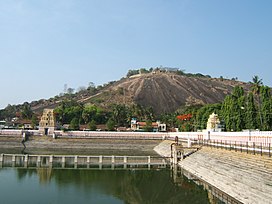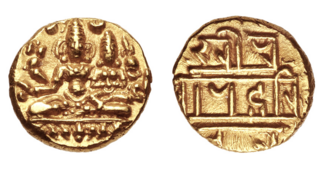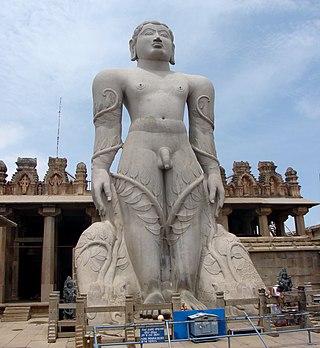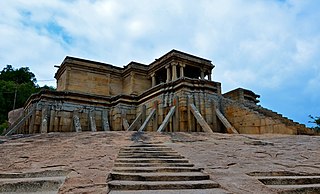| Vindhyagiri Hill | |
|---|---|
 Vindhyagiri hill from the ground |
Vindhyagiri is one of the two hills in Shravanabelagola in the Indian state of Karnataka. The other one being Chandragiri.
| Vindhyagiri Hill | |
|---|---|
 Vindhyagiri hill from the ground |
Vindhyagiri is one of the two hills in Shravanabelagola in the Indian state of Karnataka. The other one being Chandragiri.
Vindhyagiri is first referred to as "Per kavappu" (Large - Kalbappu) in 8th Century, but its history begins with that of Gommateshwara in the Late 10th century. A century and half later the town is named Gommatapura, after the colossus, but the hill itself is not identified with a distinctive name. The present name "Vindhyagiri" is said to be derived from vim, 'spirit', and dhya, 'meditation', as being the spot consecrated by rishis observed in the meditation on the supreme spirit.
The hill is located about 3,288 Feet from Mean sea Level and 438 Feet above the ground.

The colossus of Bahubali at the summit dominates the valley. Jain mythology informs us that the first colossus of Bahubali was installed by Bharata at Paudanapura, it is described to be about 525 spans (Maru - about a meter) high. The 58' 8" high Bahubali image on the Large Hill with 438' high granite mass forming its pedestal.
In 981 A.D., Chavundaraya, a Ganga minister converted a tor standing at the summit into a colossus. [1] Choosing a strategic opening between boulders, he also constructed a gateway (the present Akhanda Bagilu) with a large Gajalakshmi panel adorning its upper portion.
Odegal basadi is the largest basadi on Vindhyagiri hill. [2] The temple derives the name from 'Odega', i.e., soapstone used for strengthening the walls of the temple. [3] The temple houses image of Rishabhanatha, Neminatha and Shantinatha. [4]

Shravanabelagola is a town located near Channarayapatna of Hassan district in the Indian state of Karnataka and is 144 km (89 mi) from Bengaluru. The Gommateshwara Bahubali statue at Shravanabelagola is one of the most important tirthas in Jainism, one that reached a peak in architectural and sculptural activity under the patronage of Western Ganga dynasty of Talakad. Chandragupta Maurya is said to have died on the hill of Chandragiri, which is located in Shravanabelagola, in 298 BCE after he became a Jain monk and assumed an ascetic life style.

The Mahamastakabhisheka refers to the abhiṣeka (anointment) of the Jain idols when held on a large scale. The most famous of such consecrations is the anointment of the Bahubali Gommateshwara statue located at Shravanabelagola in Karnataka, India. It is an important Jain festival held once every 12 years. It is an integral part of the ancient and composite Jain tradition.

Harihara II was an Emperor of the Vijayanagara Empire from the Sangama Dynasty. He patronised the Kannada poet Madhura, a Jaina. An important work on the Vedas was completed during his time. He earned the titles Vaidikamarga Sthapanacharya and Vedamarga Pravartaka.

Bahubali was the son of Rishabhanatha and the brother of the chakravartin Bharata. He is a revered figure in Jainism. He is said to have meditated motionless for 12 years in a standing posture (kayotsarga), with climbing plants having grown around his legs. After his 12 years of meditation, he is said to have attained omniscience.
Narasimha I was a ruler of the Hoysala Empire. His victory over his overlord Western Chalukya Empire King Tailapa III paved the way for the declaration of independence by his successor, and is his main legacy. Tailapa III was killed by Narasimha I. He however failed to meet the challenge of their Kalachuri feudatory Bijjala II. Narasimha I was overthrown by his son Veera Ballala II.

Cāmuṇḍarāya or Chavundaraya was an Indian Jain ruler. He served in the court of the Western Ganga dynasty of Talakad. A person of many talents, in 981 he commissioned the construction of the monolithic statue of Bahubali, the Gomateshwara, at Shravanabelagola, an important place of pilgrimage for Jainism. He was a devotee of the Jain Acharya Nemichandra and Ajitasena Bhattaraka and was an influential person during the reigns of Marasimha II Satyavakya, (963–975). Rachamalla IV Satyavakya, (975–986) and Rachamalla V (Rakkasaganga), (986–999).

Karnataka, a state in South India has a long association with Jainism, a religion which enjoyed patronage of major historic kingdoms in the state such as the Rastrakuta Dynasty, Western Ganga, Kadamba and Chalukya dynasties and the Hoysala Empire. Today the state is home to a number of Jain monuments, such as temples, Gommata statues and stambhas.

Chandragiri is one of the two hills in Shravanabelagola in the Indian state of Karnataka, the other one being Vindhyagiri. It is also near Indragiri.

Chandragupta basadi is one of the smaller basadis located on the Chandragiri Hill in Sravanabelagola in the Indian state of Karnataka. Archaeological Survey of India has listed the Chandragupta basadi in group of monuments in Shravanabelagola as Adarsh Smarak Monument.

Jainism in North Karnataka flourished under the Chalukyas, Kadamba, Rashtrakutas, and Vijayanagara Empire. Imbued with religious feeling, patronage was extended towards the building of Jain temple and it garnered high repute among the people, particularly the ruling classes and the mercantile community; effectively getting treated as the state religion.

Jina Kanchi Jain Math, Melsithamur, is a Jain Matha that is located near Gingee, Villupuram district, Tamil Nadu, India.

Akkana Basadi is a Jain temple (basadi) built in 1181 A.D., during the rule of Hoysala empire King Veera Ballala II. The basadi was constructed by the devout Jain lady Achiyakka, wife of Chandramouli, a Brahmin minister in the court of the Hoysala king. The main deity of the temple is the twenty-third Jain Tirthankar Parshwanath. The temple is protected as a monument of national importance by the Archaeological Survey of India. It is part of an Archaeological Survey of India Adarsh Smarak Monument along with other temples in the Shravanabelagola group of monuments.

Shantinatha Basadi, a Jain temple dedicated to the sixteenth Tirthankar Shantinatha is located in the historically important temple town of Jinanathapura near Shravanabelagola. It is a village in Channarayapatna taluk in the Hassan district of Karnataka state, India.

Jain hoysala complex in Halebidu, Hassan district consists of three Jain Basadis dedicated to the Jain Tirthankars Parshvanatha, Shantinatha and Adinatha. The complex is situated near Kedareshwara temple and Dwarasamudra lake. The temple complex also includes a step well called Hulikere Kalyani.

Chavundaraya basadi or Chamundaraya basadi or Boppa-Chaityalya is one of the fifteen basadis located on the Chandragiri Hill in Shravanabelagola in the Indian state of Karnataka. Archaeological Survey of India has listed the Chavundaraya basadi in group of monuments in Shravanabelagola as Adarsh Smarak Monument.

The Humcha Jain temples or Humcha basadis are a group of temples found in Humcha village of Shimoga district in Karnataka, India. They were constructed in the 7th century CE in the period of the Santara dynasty and are regarded as one of the major Jain centres of Karnataka. The Padmavati Basadi is the most well-known of these temples.

Odegal basadi or Vadegal basadi is the largest basadi located on the Vindhyagiri Hill in Shravanabelagola in the Indian state of Karnataka.

Gommateshwara statue, Karkala is located at Karkala in the Indian state of Karnataka. It is the second tallest statue of Bahubali in the world with the largest statue located at Shravanabelagola.

Parshvanatha Basadi or Kamatha Parshvanatha Basadi is a Jain temple (basadi) located on Chandragiri Hill in Shravanabelagola, a town in Karnataka, India.

Bhandara Basadi or Chaturvimsati Tirthankar Basadi is a Jain temple (basadi) built in located in Shravanabelagola, a town in Karnataka, India.